Mogens Enger (1894-1918) was a Danish actor and director in the German silent cinema. In 1918 he died at the age of 24 because of the Spanish flu.

German postcard by NPG, no. 429. Photo: Alex Binder.
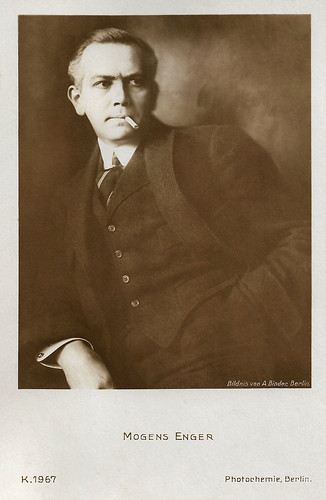
German postcard by Photochemie, Berlin, no. K. 1967. Photo: Alex Binder, Berlin.
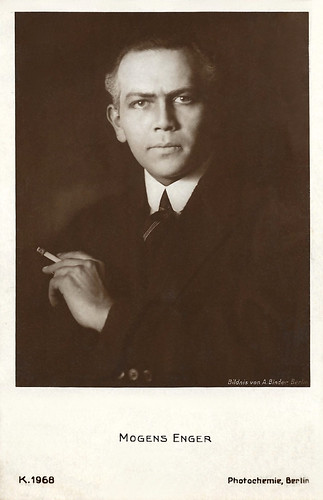
German postcard by Photochemie, Berlin, no. K. 1968. Photo: Alex Binder, Berlin.
Mogens Enger was born on 21 January 1894 in Copenhagen, Denmark. He was the son of bank manager Christian Enger. Probably his film debut was as a detective in the crime film Det røde Alfabet/The Red Alphabet (Holger Rasmussen, 1915-1916) with Einar Bruun. Enger seems to have had a lead right away, judging the photos of this film on the site of the Danish Film Institute. This was followed by a film for the Dania Biofilm Kompagni, Doktor Mors/Doctor Mors (unknown director, 1916) starring Poul Reumert. However, the usually well-informed site Danske Film lists Doktor Mors as being from 1914.
Between 1915 and 1918 Enger was active in the German silent cinema. As crime films were popular in Germany during the First World War, Enger would often if not always play detectives and crime police commissioners. He first acted in William Kahn's Der Fall Klerk/The Klerk case, shot in 1915, and released in Berlin in February 1916, at the Berlin Tauentzien-Palast. Enger immediately got the lead in this film. The film deals with a man (Enger) suspected of murdering his father (Emil Rameau), but X-rays clear this suspicion.
Enger subsequently became the hero as a detective in two Harry Piel crime films, Das geheimnisvolle Telephon/The Mysterious Phone (Harry Piel, 1916) and Unter heißer Zone/Under Hot Xone (Harry Piel, 1916) with Victor Janson and Martha Novelly. After this he acted as the male lead opposite Hella Moja in three films by Otto Rippert made for Decla: Der Schwur der Renate Rabenau/The oath of Renate Rabenau (1916-17), Wenn die Lawinen stürzen/When the avalanches fall (1916-17), and Wer küßt mich?/Who kisses me? (1916-17).
Other films from 1916 with Enger were Wahn und Wahnsinn (Carl Schönfeld, 1916), Und das Blatt wendet sich/And the tide is turning (Preben Rist, 1916) with Henny Porten, Die Nicht sterben sollen/Those who shouldn't die (dir. unknown, 1916), and the Danish film Natekspressens Hemmelighed/The Secret of the Night Express (dir. unknown, 1916) again with Enger as a detective.
In 1917 he could be seen for Eiko in Blinder Lärm/Blind noise (dir. unknown, 1917) with Hanne Brinkmann, Die Bronzeschale/The Bronze Bowl (Rudolf Del Zopp, 1917) with Sybil Smolova, Eine Perle auf dunklem Grunde/A pearl on a dark background (Rudolf Del Zopp, 1917), Der Giftbecher/The poison cup (Fred Stranz, 1917), Der Fall Routt/The Routt Case (William Kahn, 1917), and the Danish spy film I Spionklør/In Spy claws (dir. unknown, 1917).
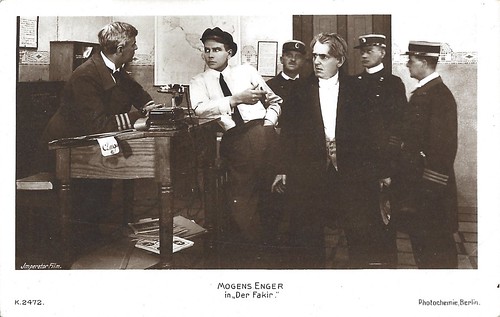
German postcard by Photochemie, Berlin, no. K.2472. Photo: Imperator Film. Mogens Enger in Der Fakir/The Fakir (Siegfried Dessauer, 1918).

German postcard by Photochemie, Berlin, no. K. 2473. Photo: Imperator Film. Mogens Enger in Der flammende Kreis/The flaming circle (Siegfried Dessauer, 1918).
In 1917 Mogens Enger joined the company Imperator-Film with a series of films starring himself, first the war propaganda film Hoch klingt das Lied vom U-Boot-Mann/Das Heldenleben des Erfinders der U-Boote Wilhelm Bauer/The song of the submarine man sounds high (Kurt Matull, 1917) with Enger as the inventor of the German submarine.
From Das verrufene Schloss Greifenstein/Ben Kabara (Siegfried Dessauer, 1917), Enger could be seen in crime films as crime police commissioner Ernst. Die Spur im Schnee/Der Schatten im Fenster/The Trail in the Snow (Siegfried Dessauer, Kurt Matull, 1917) with Hanne Brinkmann, and Das Geheimnis der Wetterfahne/The Secret of the Weather vane (Kurt Matull, 1917) with Victor Janson, followed with Enger as Detective Commissioner Ernst.
Enger directed himself in a two-part film: Marineleutnant von Brinken. 1. - Der Schuldschein des Pandola/Pandola's promissory note (Mogens Enger, 1917) and Marineleutnant von Brinken. II - Das Goldtal/The gold valley (Mogens Enger, 1918).
In 1918 he also acted in Der eiserne Käfig/The iron cage (Siegfried Dessauer, 1918), Der König der Nacht/The King of the Night (Siegfried Dessauer, 1918), Der flammende Kreis/The Flaming Circle (Siegfried Dessauer, 1918), Falsches Geld/Wrong money (Kurt Matull?, Siegfried Dessauer, 1918), Der Fakir/The faki (Siegfried Dessauer, 1918), and Kinder der Liebe I./Children of love I. (Siegfried Dessauer, Mogens Enger, 1919) with Charlotte Böcklin.
During the shooting of Kinder der Liebe I., Mogens Enger died on 9 October 1918, at the age of only 24. He was a victim of the third wave of the pandemic the Spanish Flu. Siegfried Dessauer had to finish the film. Mogens Enger was married to Gertrud Enger, born Wittrup. In 1919 she remarried with director and actor Emil Johannes Zuergius Nissen.
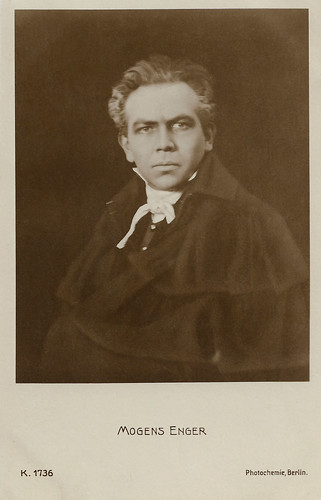
German postcard by Photochemie, Berlin, no. K. 1736.
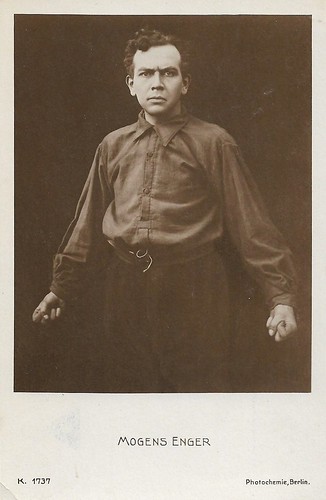
German postcard by Photochemie, Berlin, no K. 1737.
Sources: DFI, Early German Film Database, Filmportal.de, Wikipedia (German), and IMDb.
This post was last updated on 17 February 2024.

German postcard by NPG, no. 429. Photo: Alex Binder.

German postcard by Photochemie, Berlin, no. K. 1967. Photo: Alex Binder, Berlin.

German postcard by Photochemie, Berlin, no. K. 1968. Photo: Alex Binder, Berlin.
Detectives and crime police commissioners
Mogens Enger was born on 21 January 1894 in Copenhagen, Denmark. He was the son of bank manager Christian Enger. Probably his film debut was as a detective in the crime film Det røde Alfabet/The Red Alphabet (Holger Rasmussen, 1915-1916) with Einar Bruun. Enger seems to have had a lead right away, judging the photos of this film on the site of the Danish Film Institute. This was followed by a film for the Dania Biofilm Kompagni, Doktor Mors/Doctor Mors (unknown director, 1916) starring Poul Reumert. However, the usually well-informed site Danske Film lists Doktor Mors as being from 1914.
Between 1915 and 1918 Enger was active in the German silent cinema. As crime films were popular in Germany during the First World War, Enger would often if not always play detectives and crime police commissioners. He first acted in William Kahn's Der Fall Klerk/The Klerk case, shot in 1915, and released in Berlin in February 1916, at the Berlin Tauentzien-Palast. Enger immediately got the lead in this film. The film deals with a man (Enger) suspected of murdering his father (Emil Rameau), but X-rays clear this suspicion.
Enger subsequently became the hero as a detective in two Harry Piel crime films, Das geheimnisvolle Telephon/The Mysterious Phone (Harry Piel, 1916) and Unter heißer Zone/Under Hot Xone (Harry Piel, 1916) with Victor Janson and Martha Novelly. After this he acted as the male lead opposite Hella Moja in three films by Otto Rippert made for Decla: Der Schwur der Renate Rabenau/The oath of Renate Rabenau (1916-17), Wenn die Lawinen stürzen/When the avalanches fall (1916-17), and Wer küßt mich?/Who kisses me? (1916-17).
Other films from 1916 with Enger were Wahn und Wahnsinn (Carl Schönfeld, 1916), Und das Blatt wendet sich/And the tide is turning (Preben Rist, 1916) with Henny Porten, Die Nicht sterben sollen/Those who shouldn't die (dir. unknown, 1916), and the Danish film Natekspressens Hemmelighed/The Secret of the Night Express (dir. unknown, 1916) again with Enger as a detective.
In 1917 he could be seen for Eiko in Blinder Lärm/Blind noise (dir. unknown, 1917) with Hanne Brinkmann, Die Bronzeschale/The Bronze Bowl (Rudolf Del Zopp, 1917) with Sybil Smolova, Eine Perle auf dunklem Grunde/A pearl on a dark background (Rudolf Del Zopp, 1917), Der Giftbecher/The poison cup (Fred Stranz, 1917), Der Fall Routt/The Routt Case (William Kahn, 1917), and the Danish spy film I Spionklør/In Spy claws (dir. unknown, 1917).

German postcard by Photochemie, Berlin, no. K.2472. Photo: Imperator Film. Mogens Enger in Der Fakir/The Fakir (Siegfried Dessauer, 1918).

German postcard by Photochemie, Berlin, no. K. 2473. Photo: Imperator Film. Mogens Enger in Der flammende Kreis/The flaming circle (Siegfried Dessauer, 1918).
The pandemic of the Spanish Flu
In 1917 Mogens Enger joined the company Imperator-Film with a series of films starring himself, first the war propaganda film Hoch klingt das Lied vom U-Boot-Mann/Das Heldenleben des Erfinders der U-Boote Wilhelm Bauer/The song of the submarine man sounds high (Kurt Matull, 1917) with Enger as the inventor of the German submarine.
From Das verrufene Schloss Greifenstein/Ben Kabara (Siegfried Dessauer, 1917), Enger could be seen in crime films as crime police commissioner Ernst. Die Spur im Schnee/Der Schatten im Fenster/The Trail in the Snow (Siegfried Dessauer, Kurt Matull, 1917) with Hanne Brinkmann, and Das Geheimnis der Wetterfahne/The Secret of the Weather vane (Kurt Matull, 1917) with Victor Janson, followed with Enger as Detective Commissioner Ernst.
Enger directed himself in a two-part film: Marineleutnant von Brinken. 1. - Der Schuldschein des Pandola/Pandola's promissory note (Mogens Enger, 1917) and Marineleutnant von Brinken. II - Das Goldtal/The gold valley (Mogens Enger, 1918).
In 1918 he also acted in Der eiserne Käfig/The iron cage (Siegfried Dessauer, 1918), Der König der Nacht/The King of the Night (Siegfried Dessauer, 1918), Der flammende Kreis/The Flaming Circle (Siegfried Dessauer, 1918), Falsches Geld/Wrong money (Kurt Matull?, Siegfried Dessauer, 1918), Der Fakir/The faki (Siegfried Dessauer, 1918), and Kinder der Liebe I./Children of love I. (Siegfried Dessauer, Mogens Enger, 1919) with Charlotte Böcklin.
During the shooting of Kinder der Liebe I., Mogens Enger died on 9 October 1918, at the age of only 24. He was a victim of the third wave of the pandemic the Spanish Flu. Siegfried Dessauer had to finish the film. Mogens Enger was married to Gertrud Enger, born Wittrup. In 1919 she remarried with director and actor Emil Johannes Zuergius Nissen.

German postcard by Photochemie, Berlin, no. K. 1736.

German postcard by Photochemie, Berlin, no K. 1737.
Sources: DFI, Early German Film Database, Filmportal.de, Wikipedia (German), and IMDb.
This post was last updated on 17 February 2024.
No comments:
Post a Comment